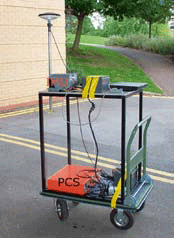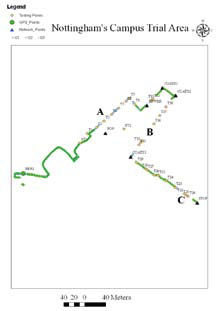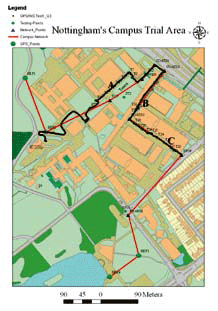| Mycoordinates | |
GPS and INS for centimeter precision during large GPS outages
|
|||||||||||||||||||||||||||||||||||||||||||
| An inertial navigation system (INS) is a self-contained navigation system that primarily measures position, velocity and attitude. The system’s inertial frame measures the accelerations and the rotations by using an inertial measurement unit (IMU). The IMU is a group of six inertial sensors which are three linear accelerometers and three gyroscopes (gyros).
The problem with IMUs is that the error from the sensors results in a drift of the position solution over time. To overcome this, other sensors (such as odometer, speedometer, compass or GPS) can be integrated with the INS to provide additional position information. For instance, GPS can be used for real-time calibration of the INS using global latitude and longitudinal coordinates. In addition, GPS and INS are ideal for integration, as their error dynamics are totally different and uncorrelated (Kaplan E. and Hegarty C., 2006). This integration between GPS and INS significantly improves the overall accuracy and reliability compared with the stand alone units (Cramer 1997). Research into GPS and INS integration is well established. There are two primary integration schemes performed through the process of Kalman filtering: loosely and tightly coupled. In the loosely coupled mode, the GPS receiver and the INS are treated as separate navigation systems. The GPS provides with a position, velocity, and time solution. The INS implements its navigation/attitude algorithms to give a position, velocity, and attitude. An integrated Kalman filter is then applied to combine the GPS and INS solutions. However, in the tightly coupled mode, only a single Kalman filter is applied to process both sets of GPS observables (code and/or phase) and INS measurements (Hide 2003). Figure 1 Multiple Steps Integration Technique Figure 2 Applanix POSRS GPS and INS In order to achieve high level of accuracy, the Applanix POSRS (a high performance GPS and INS integrated system that uses a NovAtel OEM4 GPS receiver integrated with a high quality navigation grade Honeywell Commercial Inertial Measurement Unit (CIMU)), is employed. Additionally, GPS and INS data were post-processed using different techniques (i.e. smoothed, ZUPT, etc). This research aims to develop a new technique for processing GPS/INS data to meet the requirements of the MTU project. The implementation of this uses a Multiple Steps Integration Technique (MSIT). This MSIT is involved in data collection and data processing. When collecting GPS and INS data, it is necessary to monitor the GPS availability. When GPS positions are available, it is possible to collect kinematic data. However, when working in time periods when no GPS is available, a stop and go technique is initialized using the ZUPT. Additionally, GPS and INS data should be post processed in multiple steps: GPS data preparation, GPS data post processing, converting to Applanix POSPac format and GPS and INS data integration. Using this MSIT, Root Mean Square Error (RMSE) of a few centimeters was verified for the smoothed positions along the testing points as well as in the outages. The results from different tests are analyzed and discusses herein. Multiple steps integration technique (MSIT)MSIT (Figure 1) involves both data collection and data processing. When collecting GPS and INS data, it is necessary to monitor the GPS availability. When GPS positions are available, it is possible to collect kinematic positions. However, when working in outages, a stop and go technique to initialize ZUPT must be employed. GPS/INS data should be post-processed in multiple steps to produce integrated smoothed positions as follows: • Step 1: GPS and INS data preparation. Using the POSPac software, the GPS/INS file is extracted to produce a GPS observation file and a raw IMU data file. The GPS file is then converted to Rinex format using PosGPS. The RINEX observation file is modified by adding headers in specific location in this file to distinguish between epochs on which the equipment was stopped or moving. • Step 2: GPS data post processing. A Kalman filter processing for the GPS data can be carried out within PosGPS software (this technique will be called a ‘one step technique’ or OST). However in MSIT, the modified RINEX file is post processed using the LGO software. • Step 3: The GPS Phase Solutions are now converted to a Binary Format. The phase and code or the phase solutions from LGO output can be converted to Applanix POSPac binary format using LGO2App software written by the author from either kinematic or stop and go files. However, only the phase solutions are required to be converted to Applanix format for MSIT. • Step 4: GPS and INS data integration. GPS and INS data can be loosely coupled using Applanix POSPac software (version 4.2) to produce smoothed positions. This integration is mainly dependant on using the GPS positions calculated independently using different software, e.g. LGO. So the GPS KF part in the loose integration will be replaced with an independent GPS position. MSIT is also based on using ZUPT which assists in reducing the INS drift in the GPS outages. Using this Multiple Steps Integration Technique (MSIT), a significant improvement has been noticed in the results compared with the conventional loose integration. More details about the results can be found in the following sections. GPS/INS data collection and processingThe GPS/INS data were collected using The University of Nottingham’s Applanix POSRS system fixed on a platform (Figure 2). Initially, GPS and INS data were collected along a predefined trial route (Taha 2007). The Applanix POSRS is a high performance GPS and INS integrated system that uses a Novatel OEM4 GPS receiver integrated with a high quality navigation grade Honeywell CIMU. Such a high specification system can cost the user over £100,000. Before moving the platform along the trial route and collecting the GPS and IMU data, it is necessary to collect GPS and IMU data, in static mode, for about 20 minutes preferably in an open sky area. This data is required for initialization in order to define the INS alignment (static alignment). GPS/INS data were collected on 7th September 2006 (GPS week of 1391), along the trial route, stopping for at least about 60 seconds on each of the known points. The stopping time was noted down during the test and all the data was collected and stored in the POSRS system. GPS/INS data were post-processed using two different methods: the first processing we call the ‘One Step Technique’ (OST) and the second one is the MSIT. The only difference between the two techniques is in the post-processing of the GPS data. In the MSIT, the GPS data is post-processed following the strategy described previously in this paper. For both techniques OST and MSIT, the stored raw GPS and IMU data were extracted using Extract POS Data in Applanix POSPac software. The data extraction allows the detecting of potential data problems, such as gaps in the IMU data. The collected data had one gap In the IMU data of 0.01 second. According to Hide (2008) ‘Gaps of 0.005 and 0.01s are pretty negligible since the rotation and acceleration are unlikely to vary much in this time and this is very close to the IMU data rate’. In the OST, the GPS and INS data were post processed using the Applanix POSPac software (version 4.2). This software uses the loosely coupled GPS and INS algorithms to produce smoothed positions. The loosely coupled system uses the GPS calculated position to aid the INS; therefore RTK GPS positions are first calculated. Within POSPac, this can be performed using the PosGPS software. In general, the default options of the PosGPS processing parameters were used; however, the elevation mask was modified to 10º and the datum to WGS84. Also the option to reject any GPS measurements worse than Quality 3 was implemented. In PosGPS, the quality number can be between 1 and 6 depending on the solution calculated. Table 1 summarizes the quality number description: color, meaning and accuracies of these quality numbers (the accuracies given are only guidelines) (Waypoint-Consulting-Inc. 2004). Forward and reverse GPS solutions can be combined to produce the final GPS position solution (therefore the described results are achieved using post processing only and cannot be recreated in real-time). After post-processing the GPS data using PosGPS (as in OST) or using the strategy described in MSIT, both the GPS and IMU data were post-processed using the POSProc part of POSPac. The automatic Zero-Velocity Update (ZUPT) technique was also used to detect when the IMU is static. ZUPTs are used to mitigate the IMU drift when stationary which results in an improved position solution. The lever arm between reference point and IMU and the reference point and GPS were stored in the Subsystems Setup. Besides, Kalman filter measurement rejections in the Inertial Integrated Navigation (IIN) setup were modified from 50 to 300. This is because the filter was terminated and there were no integrated solution. Other processing parameters are used as in the default values (for detail see (Applanix-Corporation 2005)). Three tests were carried out on the GPS/ INS data set using different processing techniques. The first two tests (Test1 and Test2) are carried out using OST with different GPS data post processed. Test3 uses MSIT to process the data. GPS/INS results and analysisThe following section discusses and analyses the GPS/INS tests and results. Test1 will be analyzed alone, following that Test2 and Test3 will be analyzed together. This is to make the comparison between the OST and the MSIT easier. The analysis will include the availability of the GPS solution and the accuracy of the GPS/INS integrated solution. It is worth mentioning that the GPS solution will not be analyzed in terms of accuracy since the GPS antenna was not perpendicular on the testing points and would therefore need to be corrected for tilt before accurate analysis could be made. Figure 3 Test1: GPS data processing results (combined solution: Q1, Q2 & Q3) Figure 4 Test1 GPS and INS smoothed positions Following the processing strategy described previously, the GPS positioning results from the combined solution called ‘Test1’ are shown in Figure 3. From Figure 3, the different qualities (+Q1, +Q2 and +Q3) of GPS position solutions were calculated for the positions of the known points. Moreover, there are several areas with GPS outages, highlighted using the letters A, B and C. The length of time without any GPS positions yields a challenge when trying to solve for a position to centimeter level depending only on the IMU data. The processing results from the GPS and INS combined solution data can be computed as a forward solution or a smoothed (forward and backward) solution. The forward solution can be calculated in real time. The main limitation of this solution is that large gaps where no GPS position are available result in a large drift away from the truth as the position will only be computed from the INS measurements. As mentioned before, the INS errors grow very fast over time, therefore when the data is post-processed using the forward and backward (smoothed) solutions, the INS errors during the GPS gaps are minimized. For this reason, the smoothed solution results will be discussed herein. Integrated Inertial Navigation coordinates (WGS84 geographic coordinates) obtained from the smoothed solution are converted to National Grid (OSGB36) coordinates using Grid-InQuest version ‘6.0.8’ software and are shown on an Ordnance Survey MasterMap (Figure 4). From Figure 4 the GPS and INS integration solution fill the gaps in areas A, B, and C. This illustrates the advantages of such integration between the GPS and the INS which ensure high availability, in this case 100% availability, positioning along the trial route. However, the important factor of the position is to be accurate. For this purpose, the resultant grid coordinates were averaged for each of the testing points and compared with the ‘truth’ coordinates (Figure 5). The points which have a small difference when compared to the ‘truth’ coordinates in the integrated solution are those which have a Q1 or Q2 GPS position available. However, large differences occurred in the points where there is no GPS available or the GPS position is only Q3. Test1 has shown that using the OST the maximum drift of the IMU is 1.607m East 0.703m North 1.183m Up when there are no GPS positions for a period of approximately 20 minutes. From the analysis in Test1, it is clear that the GPS solution using Q1, Q2 and Q3 reduces the position accuracy. For this reason, the same GPS and INS data in Test1 were post-processed twice, once using only Q1 and Q2 GPS positions and another one following the MSIT. The removal of Q3 positions as well as the use of the phase solution of the MSIT increased the GPS outages in Test2 and in Test3. The testing points from T2 to T8 (in area A in Figure 3) have a Q3 GPS solution, a large GPS outage occurred in this area after the removal of Q3 positions and the use of phase solutions only. These outages could be due to inability of the processor to solve for integer ambiguity in these specific environments. The resultant coordinates of Test2 were converted to OSGB36 grid coordinates, averaged and compared with the ‘truth’ coordinates. The maximum position errors of 1.640m and 1.170m in the E and Ht coordinates of COATS3 respectively. This due to the fact that this area was the most difficult area to collect good GPS positions in. Comparing the results of Test1 with the results from Test2 , it is clear that Test2 resulted in the more accurate coordinates. This is due to the removal of the Q3 GPS positions which reduced the accuracy of the integrated positions in Test1. However, the accuracy achieved in Test2 is still not good enough to meet the accuracy requirements for this research. Therefore, another attempt was carried out to post-process the GPS/ INS data based on Q1 GPS positions only. This attempt was not successful and the integration fails to calculate any positions. This was one of the reasons for developing the MSIT to overcome such limitations. Figure 6 shows the results of Test3 compared with the ‘truth’. Comparing the results of Test3 with the two previous tests shows a significant improvement in accuracy when using the MSIT. In general, the RMSE of 0.047m, 0.058m and 0.043m with maximum positions error of 0.148m, 0.142m and 0.166m have been achieved in E, N and Ht respectively in Test3. ConclusionA Multiple Steps Integration Technique (MSIT) has been developed as a loosely coupled integration of GPS and INS. When collecting GPS and INS data, it is necessary to monitor the GPS availability. When GPS positions are available, it is possible to collect kinematic positions. The GPS/INS data processing is conducted in four steps to produce smooth integrated positions. The key point of the data processing is the use of GPS phase positions calculated independently using different software, e.g. LGO. In addition, MSIT is based on using ZUPT which assists by reducing the INS drift when no GPS positions are available. Overall, from the discussion and the analysis above, it is clear that high positional accuracy can be achieved in urban environments if GPS positions are available. As well as achieving positions 100% of the time. The integrated positions using OST are highly dependent on the GPS position quality. If, for example, GPS positions with Q1 are available, it is expected that the position solution will achieve a high level of accuracy. However, as the GPS outages increase the integrated position accuracy based on OST will reduce. The use of ZUPT technique has been shown to be and advantage in assisting to reduce the INS drift in the areas without GPS positions and hence increasing the final position accuracy. To overcome the limitation of OST, the MSIT offers higher positional accuracy especially over the very large GPS outage areas (up to 20 minutes in this research). AcknowledgmentsThe authors would like to thank the Engineering and Physical Sciences Research Council for sponsoring the Mapping the Underworld project. They would also like to thank Dr Chris Hide for his support and expert advice on INS device and software. ReferencesApplanix-Corporation (2005). POS RS User Guide. Canada. Cramer, M. (1997). GPS/INS Integration. Photogrammetry Week 97. Stuttgart, Germany: pp. 1-10. Hide, C. (2003). Integration of GPS and Low Cost INS measurements. IESSG. Nottingham, The University of Nottingham. Hide, C. (2008). IMU Continuity – Personal Communication. Kaplan, E. D. and Hegarty, C. J. (2006). Understanding GPS : principles and applications. -2nd ed. Boston, Mass, Artech House. Taha, A. (2007). A continuous Updating Technique for Loosely Coupled RTK GPS with Total-Station Observations. Proceedings of ION GNSS 2007, Fort Worth Convention Center, Fort Worth, Texas Waypoint-Consulting-Inc. (2004). Guide to Using PosGPS: Refenence Manual. |
|||||||||||||||||||||||||||||||||||||||||||
|
|||||||||||||||||||||||||||||||||||||||||||
|




















 (No Ratings Yet)
(No Ratings Yet)






Leave your response!